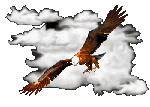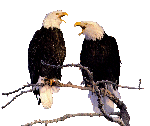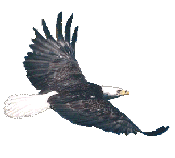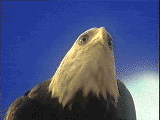|
Biography:
Bald Eagles are not bald. They got the name from an old English word "balde" meaning white. A pair of Bald Eagles will remain together for each nesting season as long as both are alive. They engage in various greeting and courtship flights, the most spectacular of which consists of locking talons in midair and descending for several hundred feet in a series of spiraling somersaults. Two adults sitting in close proximity will almost certainly be a pair.
Return to Top
Body Description:
Adults have a blackish-brown back and breast; a white head, neck, and tail; and yellow feet and bill. Juvenile bald eagles are a mixture of brown and white; with a black bill in young birds. The adult plumage develops when they're sexually mature, at about 4 or 5 years of age. Immature bald eagles may be mistaken for Golden Eagles. Bald eagle heads appear to be substantially greater than half the tail length, more like 2 thirds, whereas Golden Eagle heads are barely 1/2 as long. All when seen from below on a bird in flight.
Talons are extra-large and grooved underneath, and the foot pads rough, almost needle-like, for increased grasping ability, vital when the prey is a large slippery fish. The beak is very heavy (fishing eagles have some of the most powerful beaks. An adult eagle has 7,000 feathers. They nest in a tree and the female can have up to 3 eggs. Both male and female will incubate the eggs. Incubation lasts 34 to 36 days.
Return to Top
Eyesight:
Bald Eagles have excellent eye sight, as do all raptors. Eagles, and other hawks, have a two fovea in each eye...two centers of focus on the retina. The "regular" one is for focusing on the horizontal plane. The other is higher on the retina and concentrates focus toward the ground. The birds not only see and process two images, one from each eye, as do most animals with eyes on the sides of their heads, but they also process two more images from below themselves... four things at once. That explains why a perched bird will sometimes turn its head completely upside down when looking skyward. The ground-image fovea is then looking up.
Return to Top
Diet:
Bald Eagles eat fish, mostly salmon (usually dead or dying, small mammals such as rabbits, water fowl, seabirds and carrion. Bald eagles were almost extirpated from the United States due to DDT thinning the egg shells. Eagles sit at the top of the food chain, making them more vulnerable to toxic chemicals in the environment, since each link in the food chain tends to concentrate chemicals from the lower link.
Return to Top
Life Expetancy:
Wild bald eagles may live as long as thirty years, but the average lifespan is probably about fifteen to twenty years. They utilize feeding, day roost and night roost perches, and there is a definite dominance hierarchy for their use. When hunting, they will often pendulum over a group of birds. This works well to intimidate them, often sending one or more into panic, making them for an easy prey.
Return to Top
Voice: 
Shrill, high pitched, and twittering are common descriptions used for bald eagle vocalizations. Eagles do not have vocal cords. Sound is produced in the syrinx, a bony chamber located where the trachea divides to go to the lungs. Bald eagle calls may be a way of reinforcing the bond between the male and female, and to warn other eagles and predators that an area is defended.
Return to Top
Bald Eagle Size:
Female: Average Weight is 12.8 lbs. Body length is 35 to 37 inches, slightly larger than the male. With a wingspan which varies from 79 to 90 inches.
Male: Average Weight is 9 lbs. Body length is 30 to 34 inches. The wingspan ranges from 72 to 85 inches. The golden eagle is larger than the bald eagle in average height and wingspan, but there isn't much difference in their average weight.
Return to Top
Soaring with the Eagle:
Soaring is accomplished with very little wing-flapping, enabling them to conserve energy. Long-distance migration flights are accomplished by climbing high in a thermal, then gliding downward to catch the next thermal, where the process is repeated.
An eagles wings are long and broad, making them effective for soaring. To help reduce turbulence as air passes over the end of the wing, the tips of the feathers at the end of the wings are tapered so that when the eagle fully extends its wings, the tips are widely separated.
To help them soar, eagles use thermals, which are rising currents of warm air and updrafts generated by terrain, such as valley edges or mountain slopes.
|








